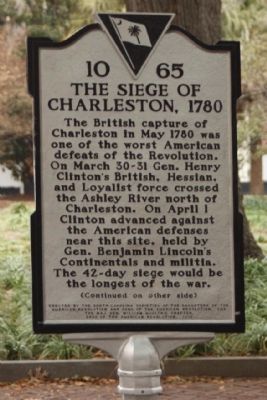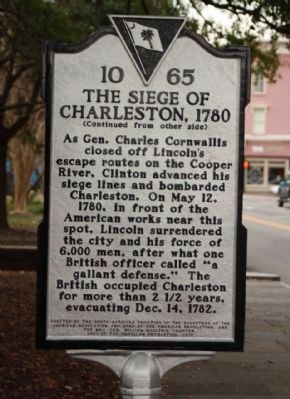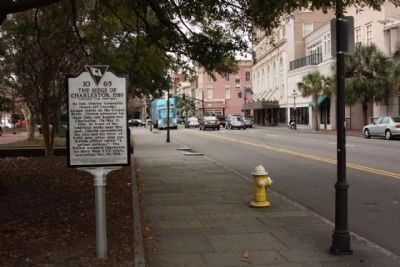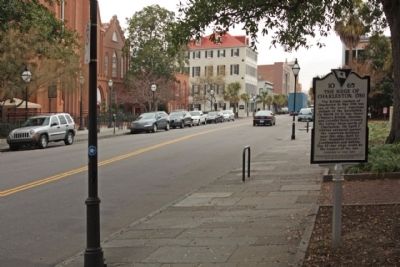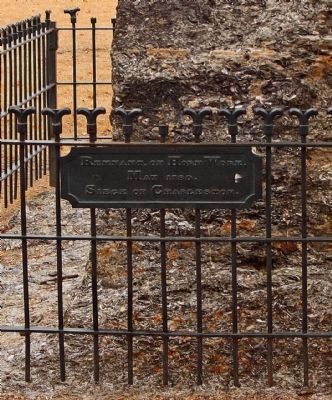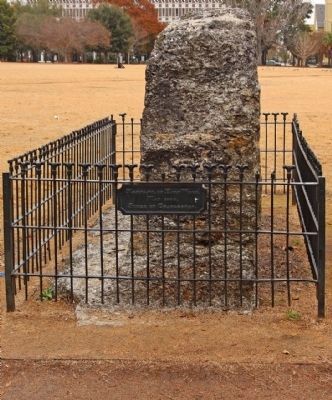Radcliffeborough in Charleston in Charleston County, South Carolina — The American South (South Atlantic)
The Siege of Charleston, 1780
As Gen. Charles Cornwallis closed off Lincoln’s escape routes on the Cooper River, Clinton advanced his siege lines and bombarded Charleston. On May 12, 1780, in front of the American works near this spot, Lincoln surrendered the city and his force of 6,000 men, after what one British officer called “a gallant defense.” The British occupied Charleston for more than 2 1/2 years, evacuating Dec. 14, 1782.
Erected 2010 by The South Carolina Societies of the Daughters of the American Revolution and Sons of the American Revolution, and the Maj. Gen. William Moultrie Chapter, Sons of the American Revolution. (Marker Number 10-65.)
Topics and series. This historical marker is listed in this topic list: War, US Revolutionary. In addition, it is included in the Daughters of the American Revolution , and the Sons of the American Revolution (SAR) series lists. A significant historical month for this entry is March 1917.
Location. 32° 47.187′ N, 79° 56.198′ W. Marker is in Charleston, South Carolina, in Charleston County. It is in Radcliffeborough. Marker is on King Street near Calhoun Street, on the left when traveling south. Located west side of Marion Square. Touch for map. Marker is in this post office area: Charleston SC 29403, United States of America. Touch for directions.
Other nearby markers. At least 8 other markers are within walking distance of this marker. Board of Field Officers of the Fourth Brigade (within shouting distance of this marker); Remnant of Horn Work (within shouting distance of this marker); The Liberty Trail (within shouting distance of this marker); Charleston’s Horn Work (within shouting distance of this marker); Marion Square (within shouting distance of this marker); Defending Independence (about 300 feet away, measured in a direct line); Charleston Public Water System (about 300 feet away); Calhoun (about 300 feet away). Touch for a list and map of all markers in Charleston.
Regarding The Siege of Charleston, 1780. Benjamin Lincoln:
After being exchanged for the British Major General William Phillips in November 1780, Lincoln returned to Washington's main army, led it south to Virginia and played a major role in the Yorktown surrender on October 19, 1781. Pleading illness, Lord Cornwallis did not attend the surrender ceremony, choosing instead to send his second-in-command, the Irish General Charles O'Hara. In response, General Washington refused to accept O'Hara's sword and sent his own subordinate, Lincoln, to receive the surrender.
He was one of the few men to have been present at the three major surrenders of the American Revolutionary War: twice as a victor (at Yorktown and Saratoga), and once as the defeated party (at Charleston). In spite of the major role he played during the war, he tends to be less well-remembered than many of his contemparies in the Continental Army.
Also see . . .
1. History of War;Siege of Charleston. In a year that saw few successes for either the British or Americans the British attack on Charleston was the major sole success of the year. 1779 saw the British capture Savannah, and it was decided to capitalize on this by sending an army 7,600 strong under General Clinton by sea to South Carolina. Charleston was the first objective of the attack. This worried Congress, who were concerned that the British could establish another strong base, similar to Savannah, in a city that had not demonstrated revolutionary zeal when briefly threatened in 1779. Congress thus put the local commander, Major-General Benjamin Lincoln, under severe pressure to retain the city. (Submitted on January 4, 2011, by Mike Stroud of Bluffton, South Carolina.)
2. The Siege of Charleston , Wikipedia entry. one of the major battles which took place towards the end of the American Revolutionary War, after the British began to shift their strategic focus towards the American Southern Colonies. After about six weeks of siege, Continental Army Major General Benjamin Lincoln surrendered forces numbering about 5,000 to the British. It was the biggest loss of troops suffered by the Continental Army in the war. (Submitted on January 4, 2011, by Mike Stroud of Bluffton, South Carolina.)
Credits. This page was last revised on February 16, 2023. It was originally submitted on January 4, 2011, by Mike Stroud of Bluffton, South Carolina. This page has been viewed 2,783 times since then and 55 times this year. Photos: 1, 2, 3, 4, 5, 6. submitted on January 8, 2011, by Mike Stroud of Bluffton, South Carolina.
